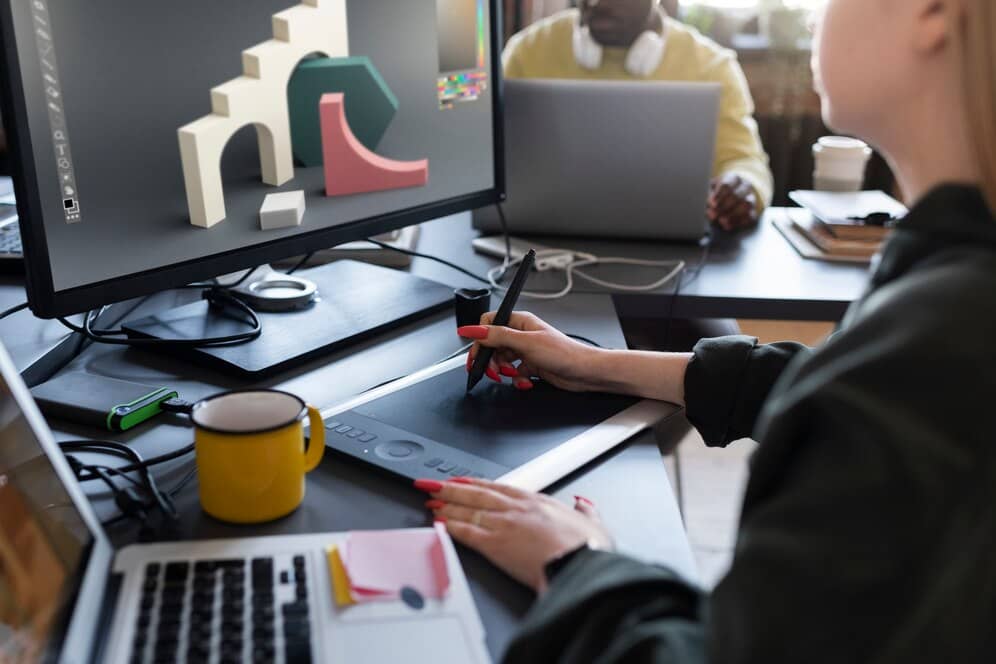What Role Do Animations And Micro-Interactions Play in Modern Website Design? Elevate UX!

Animations and micro-interactions are crucial in modern website design. They create engaging, interactive experiences for users.
In today’s digital world, websites need to stand out. Animations and micro-interactions help achieve this by providing dynamic, visually appealing elements. These features not only catch the eye but also guide users through a website. They offer feedback, making the site more intuitive and enjoyable to use.
As a result, users stay longer and have a better experience. In this blog post, we will explore the role of animations and micro-interactions in website design. We will also discuss how they can enhance user experience, making your site both functional and attractive.
Importance Of Animations
Animations and micro-interactions are crucial in modern website design. They make websites more engaging and interactive. These elements add life to static pages. They create a dynamic user experience.
Enhancing User Engagement
Animations capture the user’s attention. They can turn a mundane website into an exciting one. This keeps visitors on your site longer. They are more likely to explore and interact with your content.
- Visual Appeal: Animations make your website visually appealing.
- Interactive Elements: Users love interacting with animated elements.
- Memorable Experience: Animations create a memorable experience for users.
Adding animations to buttons or images can increase clicks. For example, a subtle bounce effect can draw attention to a call-to-action button. This encourages users to take the desired action.
Guiding User Behavior
Micro-interactions help guide user behavior. They provide feedback and show users what to do next. For instance, a form can shake to indicate an error.
| Function | Example |
|---|---|
| Feedback | Button changes color when clicked |
| Navigation | Animated scroll indicators |
| Instructions | Hover effects on menu items |
Animations can also highlight important information. For instance, a blinking icon can alert users to new messages. This ensures users do not miss key updates.
Micro-interactions In Web Design
Micro-interactions are small moments where the user and interface interact. These tiny details can make a big impact on the user’s experience. They provide feedback, show the results of actions, and help users understand the interface better. They are not just decorative but serve a functional purpose.
Defining Micro-interactions
Micro-interactions are single-task events. They usually focus on one main task. For example, liking a post on social media or toggling a switch. These actions are brief but essential for user engagement. They guide the user, show results, and offer feedback. This helps users understand what is happening on the screen.
Examples In Everyday Use
One common example is the “like” button on social media. When you click it, the heart changes color or animates. This simple action confirms your input. Another example is the progress bar. It shows how much of a task is complete. This helps users know they are on the right track.
Toggle switches are also micro-interactions. They show an action is either on or off. A small animation can make this clear. Hover effects are another example. When you move your mouse over a button, it changes color or size. This tells you the button is interactive.
Micro-interactions improve user experience by making interfaces easier to understand. They provide immediate feedback. They help users know their actions have been recognized. This can lead to more satisfying and efficient use of the website.
Improving User Experience
Animations and micro-interactions have become essential in modern website design. They can significantly improve the user experience. These elements engage visitors, making interactions more intuitive and enjoyable. Let’s explore how animations and micro-interactions achieve this.
Creating Seamless Interactions
Animations help create smooth transitions between different sections of a website. They guide users through the interface, making navigation easier. For instance, animated menus can highlight options as you hover over them. This makes it clear which option you are about to select.
Micro-interactions offer immediate feedback to user actions. A simple example is a button changing color when clicked. This small change confirms that the action has been registered. It makes the website feel responsive and interactive.
Reducing Cognitive Load
Animations can simplify complex information. Animated infographics, for example, break down data into easy-to-understand visuals. Users can grasp information quickly without feeling overwhelmed.
Micro-interactions also help by reducing the need for extensive instructions. An icon that shakes when an incorrect input is entered immediately indicates an error. This reduces the need for lengthy error messages and helps users correct mistakes swiftly.
In summary, animations and micro-interactions enhance the user experience by creating seamless interactions and reducing cognitive load. These elements make websites more engaging, intuitive, and user-friendly.

Visual Appeal And Aesthetics
Animations and micro-interactions are vital in modern website design. They enhance visual appeal and aesthetics, making websites more engaging. These elements bring a site to life, capturing user attention and improving the overall experience.
Adding Visual Interest
Animations add visual interest to a website. They make static elements dynamic and engaging. For example, a button that changes color when hovered over can grab attention. It encourages users to interact with the site. Micro-interactions, like a subtle bounce effect when clicking a button, can also enhance the user experience.
Animations can also guide users through a website. For instance, a smooth scrolling animation can lead users to important sections. This keeps them engaged and helps them navigate the site with ease.
Supporting Brand Identity
Animations and micro-interactions support brand identity. They can reflect a brand’s personality and values. A playful animation can convey a fun and friendly brand. A sleek, smooth animation can show professionalism and sophistication.
Using consistent animations across a website ensures a cohesive look and feel. This consistency helps build brand recognition and trust. Users will associate the unique animations with the brand, making the website memorable.
Functional Benefits
In modern website design, animations and micro-interactions offer significant functional benefits. These elements enhance the user experience by providing visual feedback, indicating system status, and guiding user actions. Let’s explore these benefits in detail.
Providing Feedback
Animations and micro-interactions deliver immediate feedback to users. When users click a button or submit a form, a small animation can show that the action was successful. This visual feedback reassures users and keeps them engaged.
For instance, a button might change color or a checkmark might appear. These simple animations make the interface feel responsive and intuitive.
Indicating System Status
Animations can effectively indicate system status. Loading animations, for example, inform users that the system is processing their request. This prevents confusion and reduces frustration.
Consider a spinning wheel or a progress bar. These animations show that the system is working and keep users informed.
Such indications are crucial in maintaining a smooth user experience.
| Animation Type | Purpose |
|---|---|
| Loading Spinner | Shows system is processing |
| Button Highlight | Confirms user action |
| Progress Bar | Indicates task completion |
By using animations and micro-interactions, websites can provide clear feedback and status updates. This enhances usability and keeps users informed.

Best Practices For Implementation
Animations and micro-interactions are crucial in modern website design. They can transform user experiences by making interactions smoother and more engaging. However, their implementation requires careful attention. Let’s dive into some best practices to ensure they enhance the user experience effectively.
Keeping It Subtle
Subtlety is key in animations. Overuse can overwhelm users. Ensure animations are minimalistic and do not distract from the main content. A simple hover effect on buttons can guide users without being intrusive.
Consider the following tips to keep animations subtle:
- Short Durations: Animations should be quick, ideally under 0.5 seconds.
- Natural Movement: Use smooth transitions that mimic real-world physics.
- Purposeful Animations: Every animation should have a clear purpose, such as drawing attention to a call-to-action.
Subtle animations can enhance user experience without overwhelming them.
Ensuring Consistency
Consistency in animations and micro-interactions is essential. It creates a cohesive user experience. Users should feel a sense of familiarity as they navigate through the site.
Here are some best practices for maintaining consistency:
| Aspect | Best Practice |
|---|---|
| Animation Style | Maintain a uniform style across the site. Use similar easing functions and timings. |
| Interaction Feedback | Ensure feedback animations are consistent, such as hover effects or error messages. |
| Brand Identity | Align animations with the overall brand identity to reinforce brand consistency. |
Consistency helps in creating a predictable and enjoyable user experience.
Tools And Technologies
Animations and micro-interactions have become essential in modern website design. They add life, enhance usability, and create a more engaging user experience. To implement these effectively, web designers use various tools and technologies. This section explores popular animation libraries and offers guidance on choosing the right tool for your project.
Popular Animation Libraries
Several libraries help designers create smooth animations. One of the most popular is GSAP (GreenSock Animation Platform). GSAP is known for its speed and flexibility. Another widely used library is Anime.js. It provides simple yet powerful features for creating complex animations. For those who prefer a CSS-based approach, Animate.css is a great choice. It offers a collection of ready-to-use animations.
Choosing The Right Tool
Choosing the right tool depends on your specific needs. If you need high performance and flexibility, GSAP might be the best choice. For simpler animations, Anime.js or Animate.css could be more suitable. Consider the complexity of the animations you want to create. Think about your familiarity with the tool. Ease of integration with your existing codebase is also essential. Each library has its strengths and weaknesses. Evaluate them based on your project requirements.
Case Studies
Animations and micro-interactions are key elements in modern web design. They create engaging and intuitive user experiences. Through several case studies, we can see how successful examples have harnessed these elements. We can also learn valuable lessons from their application.
Successful Examples
There are many examples of websites that use animations and micro-interactions effectively:
- Airbnb: The website uses subtle animations to guide users. For instance, the search bar expands when clicked, making it clear where to type. This simple animation improves the user experience by drawing attention to key actions.
- Dropbox: Dropbox uses animations to illustrate features. The animations make the website more engaging and help users understand the product better.
- Apple: Apple’s product pages use animations to showcase the features of their devices. These animations make the product pages more interactive and visually appealing.
Lessons Learned
From these examples, we learn several key lessons:
- Enhancing User Guidance: Animations can guide users by highlighting important actions or features. This improves navigation and usability.
- Improving Engagement: Well-designed animations can make a website more engaging. They capture the user’s attention and make the experience enjoyable.
- Clarifying Information: Animations can help explain complex concepts. This makes the information more accessible and easier to understand.
These case studies show that animations and micro-interactions play a vital role in modern web design. They enhance user experience by making websites more intuitive, engaging, and informative.
Future Trends
The future of website design is exciting and ever-changing. Animations and micro-interactions are at the forefront of this evolution. They make websites more engaging and user-friendly. As technology advances, these elements will play an even bigger role in enhancing user experience.
Evolving User Expectations
Users expect websites to be more interactive and dynamic. Simple static pages no longer meet their needs. They want a seamless and engaging experience. Animations and micro-interactions help fulfill these expectations. They make browsing more enjoyable and intuitive.
For instance, hovering over a button can trigger a subtle animation. This visual feedback assures the user that their action is recognized. It enhances the overall experience, making the website feel more responsive and alive.
Innovations In Interaction Design
New tools and technologies are emerging in interaction design. These innovations allow for more creative and complex animations. Designers can now craft unique experiences that were not possible before.
For example, motion design tools like Lottie and After Effects enable intricate animations. These tools help create smooth, high-quality animations that load quickly. They do not impact website performance negatively.
Another trend is the use of micro-interactions. These are small, engaging animations triggered by user actions. They provide instant feedback and improve usability. Examples include loading spinners, button animations, and swipe effects.
In summary, the future of website design lies in embracing animations and micro-interactions. They meet evolving user expectations and leverage new interaction design innovations. This results in a more engaging and enjoyable user experience.

Frequently Asked Questions
What Are Micro-interactions In Web Design?
Micro-interactions are small, subtle animations or design elements. They provide feedback, enhance user engagement, and improve overall user experience on a website.
How Do Animations Improve User Experience?
Animations guide users, make navigation intuitive, and provide visual feedback. They make the user journey engaging and interactive, enhancing overall satisfaction.
Why Are Animations Important In Modern Websites?
Animations add dynamism, convey information effectively, and create memorable experiences. They help in retaining users and ensuring smooth navigation.
Can Animations Slow Down A Website?
Yes, if not optimized, animations can affect loading times. Proper implementation ensures animations enhance UX without compromising performance.
Conclusion
Animations and micro-interactions are essential in modern website design. They make sites engaging and fun. Smooth transitions keep users interested. Quick responses enhance user satisfaction. Small details create big impacts. Overall, they improve the browsing experience. Designers should consider them.
Users appreciate these thoughtful touches. Effective use can elevate any website. Always aim for balance and simplicity. Your website will benefit greatly.



